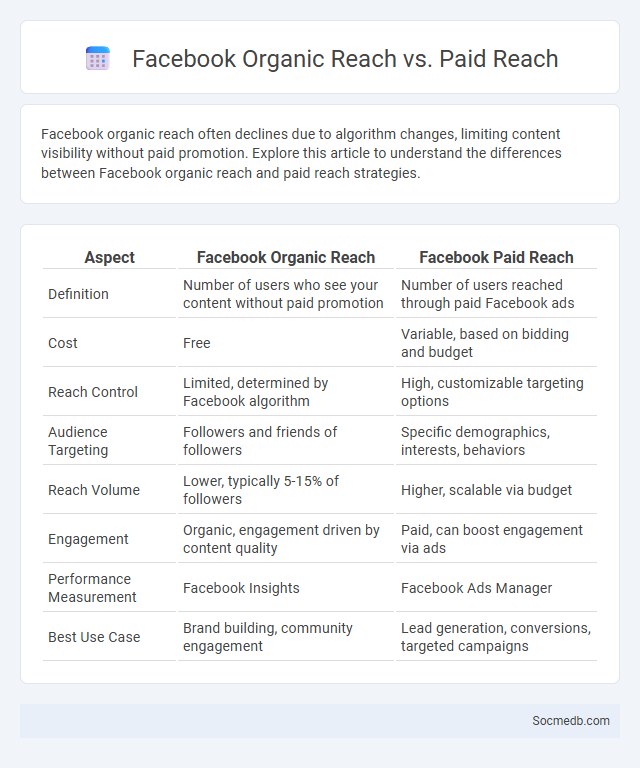
Photo illustration: Facebook Organic Reach vs Paid Reach
Facebook organic reach often declines due to algorithm changes, limiting content visibility without paid promotion. Explore this article to understand the differences between Facebook organic reach and paid reach strategies.
Table of Comparison
| Aspect | Facebook Organic Reach | Facebook Paid Reach |
|---|---|---|
| Definition | Number of users who see your content without paid promotion | Number of users reached through paid Facebook ads |
| Cost | Free | Variable, based on bidding and budget |
| Reach Control | Limited, determined by Facebook algorithm | High, customizable targeting options |
| Audience Targeting | Followers and friends of followers | Specific demographics, interests, behaviors |
| Reach Volume | Lower, typically 5-15% of followers | Higher, scalable via budget |
| Engagement | Organic, engagement driven by content quality | Paid, can boost engagement via ads |
| Performance Measurement | Facebook Insights | Facebook Ads Manager |
| Best Use Case | Brand building, community engagement | Lead generation, conversions, targeted campaigns |
Understanding Facebook Organic Reach
Facebook organic reach refers to the number of unique users who see your posts without paid promotion, which has significantly declined due to algorithm changes prioritizing personal content over business pages. Engaging content, consistent posting, and fostering genuine interactions are crucial strategies to improve organic reach on Facebook. Monitoring insights like reach metrics, engagement rates, and audience demographics helps optimize content for better visibility and extended audience engagement.
What is Facebook Paid Reach?
Facebook Paid Reach refers to the number of unique users who see your content as a result of paid advertising campaigns on the platform. This metric measures the effectiveness of your budget allocation in expanding audience visibility beyond organic reach. Understanding your Facebook Paid Reach helps optimize ad performance to maximize engagement and conversions.
Key Differences: Organic vs Paid Reach
Organic reach on social media refers to the number of users who see content without paid promotion, relying solely on platform algorithms and user engagement; it often results in lower but more authentic visibility. Paid reach involves using advertisements and sponsored posts to target specific demographics, ensuring broader and faster exposure but at a financial cost. The key difference lies in cost-efficiency versus audience control, where organic reach depends on content quality and timing, while paid reach leverages budget for precise targeting and scalability.
Factors Influencing Organic Reach on Facebook
Organic reach on Facebook is primarily influenced by content relevance, user engagement, and the algorithm's prioritization of meaningful interactions. Posts that generate higher likes, comments, and shares are favored, increasing visibility within users' news feeds. Timing and audience targeting also play crucial roles in maximizing organic impressions and interactions.
How Facebook’s Algorithm Affects Organic Content
Facebook's algorithm prioritizes content based on user engagement, relevance, and recency, which significantly impacts the visibility of organic posts. Your organic content is more likely to appear in news feeds if it generates meaningful interactions such as comments, shares, and reactions. Understanding this algorithm helps you tailor your posts to boost engagement and improve the reach without relying on paid promotion.
The Benefits of Investing in Paid Reach
Investing in paid reach on social media platforms significantly enhances your brand visibility by targeting specific demographics with precision, leading to higher engagement rates and improved conversion metrics. Paid reach amplifies content distribution beyond organic limitations, ensuring that your message reaches a broader, yet relevant audience. Leveraging advanced analytics tools provided by platforms like Facebook and Instagram empowers you to optimize campaigns for maximum ROI and growth.
Measuring the Effectiveness of Organic vs Paid Reach
Measuring the effectiveness of organic vs paid reach involves analyzing engagement metrics such as likes, shares, comments, and click-through rates to determine which strategy yields higher interaction and conversion rates. Your social media analytics tools can track the cost-effectiveness of paid ads compared to organic content's natural visibility growth. Understanding these insights helps optimize budget allocation and content strategies for maximizing overall reach and audience engagement.
Strategies to Increase Facebook Organic Reach
Maximizing Facebook organic reach requires consistent use of engaging content that resonates with your target audience, including high-quality images, videos, and interactive posts. Leveraging Facebook Groups and encouraging genuine interaction through comments and shares helps boost algorithmic visibility, enhancing your content's exposure. You should also optimize posting times based on your audience's activity patterns to increase visibility and organic engagement.
When to Use Paid Reach Over Organic
Paid reach on social media is most effective when targeting specific demographics or launching new products that require immediate visibility beyond an organic audience. Brands aiming to maximize campaign impact, increase conversions, or amplify time-sensitive promotions benefit from paid advertisements due to their precise targeting and scalable reach. Organic reach serves best for nurturing community engagement and maintaining brand loyalty but often lacks the rapid exposure needed for fast growth or competitive markets.
Integrating Organic and Paid Reach for Maximum Impact
Maximizing your social media impact requires a strategic blend of organic and paid reach to enhance engagement and brand visibility. Organic reach leverages authentic content and community interaction to build trust and long-term relationships, while paid campaigns target specific demographics to increase traffic and conversions efficiently. You can optimize performance by analyzing audience insights and adjusting your content mix to balance unpaid engagement with precise ad spending.
 socmedb.com
socmedb.com